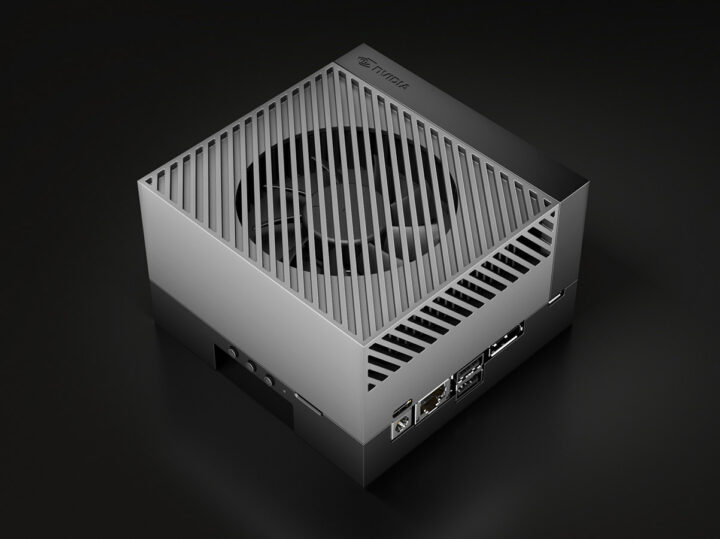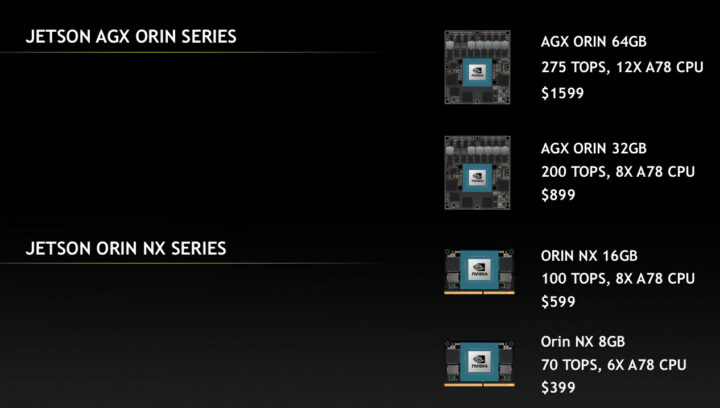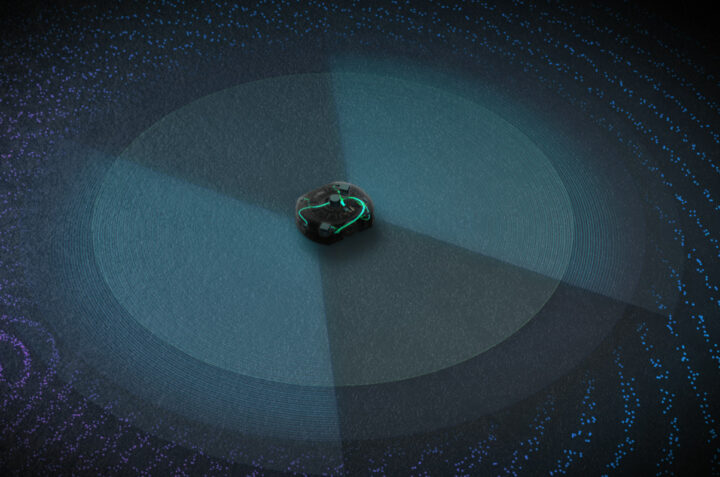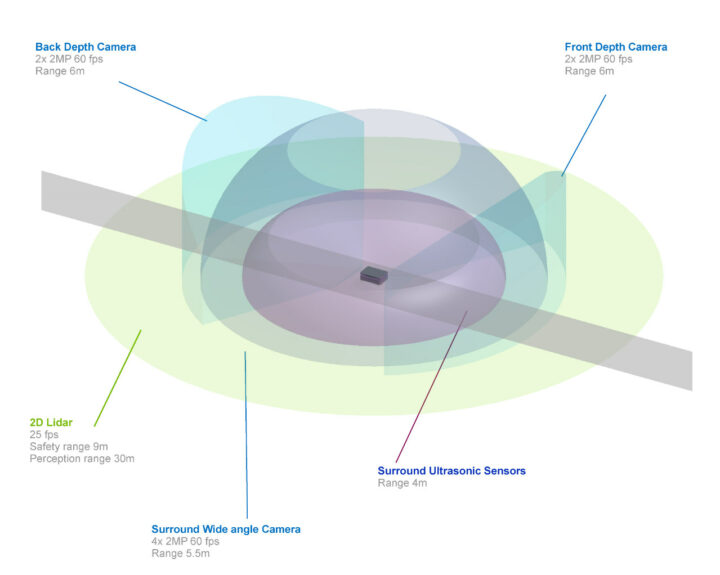NVIDIA Jetson AGX Orin module was first introduced in November 2021, but the company has now officially launched the Jetson AGX Orin Developer Kit, andunveiled the lower cost Orin NX modules still with 70 TOPS or more, and the Isaac Nova Orin AMR (autonomous mobile robot) reference platform.
NVIDIA Jetson AGX Orin Developer Kit
Jetson Orin AGX developer kit specifications:
- Jetson AGX Orin module with
- CPU – 12-core Arm Cortex-A78AE v8.2 64-bit processor with 3MB L2 + 6MB L3 cache
- GPU / AI accelerators
- NVIDIA Ampere architecture with 2048 NVIDIA CUDA cores and 64 Tensor Cores @ 1.3 GHz
- DL Accelerator – 2x NVDLA v2.0
- Vision Accelerator – PVA v2.0 (Programmable Vision Accelerator)
- AI Performance – Up to 275 TOPS (INT8) @ 60W
- Video Encode – 2x 4K60 | 4x 4K30 | 8x 1080p60 | 16x 1080p30 (H.265)
- Video Decode – 1x 8K30 | 3x 4K60 | 7x 4K30 | 11x 1080p60| 22x 1080p30 (H.265)
- System Memory – 32GB 256-bit LPDDR5 @ 204.8 GB/s
- Storage – 64GB eMMC 5.1 flash
- 699-pin Molex Mirror Mezz connector with
- Storage – Single lane UFS
- Display – 1x 8K60 multi-mode DP 1.4a (+MST), eDP 1.4a, HDMI 2.1
- Camera
- Up to 6x CSI Camera (16 via virtual channels)
- 16 lanes MIPI CSI-2
- D-PHY 2.1 (up to 40Gbps) | C-PHY 2.0 (up to 164Gbps)
- Networking – 1x GbE, 4x 10GbE
- PCIe – Up to 2x PCIe x8, 1x PCIe x4, 2x PCIe x1 (PCIe Gen4, Root Port & Endpoint)
- USB – 3x USB 3.2, 4x USB 2.0
- Low-speed IOs – 4x UART, 3x SPI, 4x I2S, 8x I2C, 2x CAN, DMIC & DSPK, GPIOs
- Power Modes – 15W, 30W, 50W, or 60W
- Dimensions – 100 x 87mm
- Carrier board
- Storage – MicroSD slot for UHS-1 cards up to SDR104 mode
- Video Output – DisplayPort 1.4a (+MST)
- Camera I/F – 16 lane MIPI CSI-2 connector
- Networking – Up to 10GbE RJ45 port
- USB
- 2x USB 3.2 Gen2 Type-A ports
- 2x USB 3.2 Gen1 Type-A ports
- 2x USB 3.2 Gen 2 Type-C ports
- 1x Micro USB 2.0 port
- Expansion
- x16 PCIe slot supporting x8 PCIe Gen4
- M.2 Key M x4 PCIe Gen 4
- M.2 Key E x1 PCIe Gen 4, USB 2.0, UART, I2S
- 40-pin header (I2C, GPIO, SPI, CAN, I2S, UART, DMIC)
- 12-pin automation header
- 10-pin audio panel header
- Debugging – 10-pin JTAG header
- Misc – 4-pin fan header; 2-pin RTC battery backup connector; power, force recovery, and Reset buttons
- Dimensions – 110 x 110 x 71.65mm (Height includes feet, carrier board, module, and thermal solution)
The kit ships with the Jetson AGX Orin module with heatsink and reference carrier board, an 802.11ac/a/b/g/n WiFi 5 module, a power adapter and USB Type-C cord, a USB Type-C to USB Type-A cord, and a Quick Start and Support Guide.
On the software side, Jetson AGX Orin can make use of the NVIDIA CUDA-X accelerated computing stack, NVIDIA JetPack SDK, pre-trained models from the NVIDIA NGC catalog, and frameworks and tools such as NVIDIA Isaac on Omniverse, NVIDIA Metropolis, and NVIDIA TAO Toolkit.
Basic support for the Jetson Orin AGX developer kit also happens to have just been added to Linux 5.17. The devkit can be purchased for $1,999 and more information can be found on the product page.
Jetson Orin NX modules
If spending close to $2,000 on a development kit, and then $1,599 on modules is not cost-effective for your project, the company provides four options, including two lower-cost SO-DIMM Orin NX modules:
- AGX Orin 64GB with 275 TOPS, 12x Cortex-A78 CPU for $1,599 (as found in the devkit)
- AGX Orin 32GB with 200 TOPS, 8x Cortex-A78 CPU for $899
- Orin NX 16GB with 100 TOPS, 8x Cortex-A78 CPU for $599
- Orin NX 8GB with 70 TOPS, 6x Cortex-A78 CPU for $399
Note the prices are for 1K unit orders, and mass production is scheduled to start in Q4 2022.
Isaac Nova Orin AMR platform
NVIDIA also introduced the Isaac Nova Orin reference platform powered by 2 Jetson AGX Orin units to speed up the development of 3D-sensing robots with up to 550 TOPS of AI compute for perception, navigation, and human-machine interaction.
The robot can handle up to six cameras, three lidars, and eight ultrasonic sensors and process data in real-time. NVIDIA is also working on new software and simulation capabilities to accelerate AMR deployments including hardware-accelerated modules, or Isaac ROS GEMs.
The video below shows AMR visual navigation using Isaac Sim and Isaac ROS, and demonstrates how virtual worlds like NVIDIA Omniverse can be used in practical applications, in this case, simulate various warehouse environments to test the robot’s capabilities.
More details about NVIDIA AMR solutions can be found on the product page.

Jean-Luc started CNX Software in 2010 as a part-time endeavor, before quitting his job as a software engineering manager, and starting to write daily news, and reviews full time later in 2011.
Support CNX Software! Donate via cryptocurrencies, become a Patron on Patreon, or purchase goods on Amazon or Aliexpress








